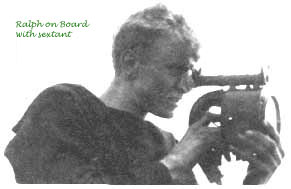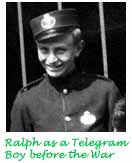

|
|||||
| Ralph Stobart Robson, signalman, life in the British Royal Navy World War Two, sinking of Prince of Wales and the Repulse, Singapore | |||||
|
|||||
|
|||||
|
Scattered around the Signal Office on the outside were various tall lockers to hold foulweather gear, etc. The sponsons were mounted so that they partly overhung the bridge rail and were entered by means of a short ladder of about six steps. The entrance to the Signal Office was on the starboard side. The first thing I had to do was shift myself and gear to the Signalmens messdeck, which was on the port side. There was no place to sling my hammock and the only place I was offered was the hammock stowage. After trying this for two nights I felt I had to complain to the Killick who said he would see about it. The next day he came back with the solution to my problem. They had found me a place near the Police Flat, below one of the main engine uptakes. This was where the fumes were taken from the engine to the funnel and slanted at a angle across the space. Now this would have been ideal if we had been on Russian Convoys, but in the Tropics it was worse than useless. The heat was tremendous and I had to sleep naked in my hammock. Every time I got out of the hammock there was a large damp patch on the bottom and drips of sweat could still be seen. Both the drips and the patch vanished like magic. Life, however, carried on and I just had to accept the situation. The only comfort was a stokehold entrance just near to where I was slinging my hammock. I got to know some of the stokers who were horrified at my sleeping quarters and every time I was in the flat they left me a fanny of oatmeal water and limejuice, which counteracted the effect of sweating and working in the heat. The limejuice was contained in a large barrel in their working space and was freely available. Life settled into a routine. Four hours on and eight off. I was no longer the messman as these duties were assigned to each one on a regular basis. I got to know the bridge staff, particularly the Chief and one of the signal boys, Henry Herron. The first watch was the forenoon, presumably because the Chief could keep his eye on me, and I looked forward to it with a certain amount of trepidation. Not much signalling took place between the Prince of Wales and the escorting destroyers, Express, Electra and Hesperus. Three days out we were joined by the H.M.S. Legion. The main thing was the daily report on the state of the destroyers, such as the amount of fuel remaining and other such items. When I had been on the smaller ships any Aldis signalling was fairly rare and usually between signalmen of the same rank as myself. Fleet signalling was done and supervised by professionals. However, the first time I had to do this I only missed one or two words which elicited no comment from the Yeoman of the watch. Henceforth there were only two of us, one reading the signal and one writing it down. We steamed down through the North Atlantic. The destroyers were ahead of us on either beam to provide Asdic cover for the big ship. My time was taken up in watchkeeping and flag hoisting exercises. The flag hoisting was my first downfall. As we were sailing south of the Azores we were engaged one morning with the flag hoisting. Practice fleet signals were sent by ourselves (acting as the Commander in Chief) to the destroyers, requiring acknowledgment and sometimes replies. The flags were clipped onto the halyard and when this was completed they were then hoisted up the yardarm attached. I was in charge of the tack, which is the upper end of the hoist. Two signal boys were in charge of joining the flags together. They were like lightening at this job and this particular time, for some unknown reason, they had joined all the flags together before attempting to attach them to the hoist. The boy in charge of the upper end of the hoist handed it to me and, in the excitement of the moment, I hauled away. In an instant the flags were streaming in the wind. The bottom clip had not been attached! The bosun, who had been supervising this exercise, went wild. I had never heard him swear before but he did that day. He then ordered me to climb the mast, go along the yardarm and pull in the hoist. I moved towards the mast, having no fear of climbing out on the yard, when the voice of the bosun halted me. "No," he said, "one of the boys will go instead of you - you'd probably fall off and break your bloody neck!" That was the first of many misdemeanors which got me in his black books. I was given another job and the hoisting continued. |
|||||
|
|||||
